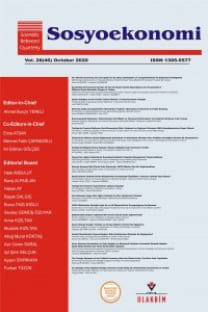COVID-19 Pandemisinde En Üst Koronavirüs Aşı Hisselerinin Performansı: Çoklu Fraktal Analiz
Bu çalışma, 9 Aralık 2019-6 Ocak 2022 arasında beş aşı hissesinin (Pfizer, BioNTech, Moderna, Johnson&Johnson ve AstraZeneca) koronavirüs pandemisinde işgünü haftalık verileri temelinde çoklu fraktal özelliklerinin nasıl etkilendiğini araştırmaktadır. Çalışmanın temel amacı sürü yatırımının ve piyasa etkinlik düzeyinin aşılama dönemi öncesinde (9 Aralık 2019 - 8 Aralık 2020) ve sonrasında (9 Aralık 2020 - 6 Ocak 2022) değişiminin varlığını ortaya koymaktır. Genelleştirilmiş Hurst üsleri çoklu fraktal eğiliminden arındırılmış dalgalanma analizi yoluyla hesaplanmaktadır. Genel olarak, ampirik sonuçlar COVID-19 salgını sırasında her aşı hissesi için çoklu fraktal varlığın mevcut olduğunu göstermektedir. Ayrıca çoklu fraktal özelliklere göre etkinlik düzeyi aşı hisseleri arasında farklılık göstermektedir. Elde edilen sonuçlar aşılama sonrası dönemin BioNTech ve Moderna hisse senetleri için sürü yatırımına daha yatkın olduğunu göstermektedir. Güncel salgının etkileri göz önüne alındığında COVID-19 aşılama sürecinin öncesi ve sonrasında en yüksek MLM (etkinsizlik) indeks değerinin BioNTech’e ait olduğu ortaya konmaktadır.
Anahtar Kelimeler:
Aşı Hisseleri, Etkinsizlik Endeksi, Genelleştirilmiş Hurst Üssü, Sürü Davranışı, COVID-19
The Performance of Top Coronavirus Vaccine Stocks during COVID-19 Pandemic: A Multifractal Analysis
This study assesses how the coronavirus pandemic (COVID-19) affects the 5-day week multifractal properties of five vaccine stocks (i.e., Pfizer, BioNTech, Moderna, Johnson&Johnson, and AstraZeneca) using weekday index data ranging from 9 December 2019 to 6 January 2022. The main concern is to document whether the presence of herd investing and the level of market efficiency changed between pre-vaccination (i.e., 9 December 2019 - 8 December 2020) and post-vaccination (i.e., 9 December 2020 - 6 January 2022). The generalised Hurst exponents are calculated through multifractal detrended fluctuation analysis. Overall, the empirical results show multifractality for each vaccine stock during the COVID-19 outbreak. Besides, the efficiency level differs among the vaccine stocks based on multifractal properties. The results indicate that the post-vaccination period is more prone to herd investing in BioNTech and Moderna stocks. Considering the impacts of this far-reaching outbreak, the highest MLM (inefficiency) index value is also attributed to BioNTech before and after the COVID-19 vaccination process.
Keywords:
Vaccine Stocks, Efficiency Index, Generalised Hurst Exponent, Herding Behaviour, COVID-19,
___
- Arshad, S. et al. (2021), “Are Oil Prices Efficient?”, Economic Modelling, 96, 362-370.
- Aslam, F. et al. (2020a), “Evidence of Intraday Multifractality in European Stock Markets during the Recent Coronavirus (COVID-19) Outbreak”, International Journal of Financial Studies, 8(2), 31.
- Aslam, F. et al. (2020b), “Investigating Long-Range Dependence of Emerging Asian Stock Markets Using Multifractal Detrended Fluctuation Analysis”, Symmetry, 12(7), 1157.
- Aslam, F. et al. (2022), “Herding Behavior during the Covid-19 Pandemic: A Comparison between Asian and European Stock Markets based on Intraday Multifractality”, Eurasian Economic Review, 12(2), 333-359.
- Caporale, G.M. et al. (2018), “Persistence in the Cryptocurrency Market”, Research in International Business and Finance, 46, 141-148.
- Di Matteo, T. (2007), “Multi-Scaling in Finance”, Quantitative Finance, 7(1), 21-36.
- Gorjão, L.R. et al. (2022), “MFDFA: Efficient Multifractal Detrended Fluctuation Analysis in Phyton”, Computer Physics Communications, 273, 108254.
- Hurst, H.E. (1951), “Long-Term Storage Capacity of Reservoirs”, Transactions of the American Society of Civil Engineers, 116(1), 770-799.
- Kantelhardt, J.W. et al. (2002), “Multifractal Detrended Fluctuation Analysis of Nonstationary Time Series”, Physica A, 316, 87-114.
- Khuntia, S. & J.K. Pattanayak (2020), “Adaptive Long Memory in Volatility of Intra-Day Bitcoin Returns and the Impact of Trading Volume”, Finance Research Letters, 32, 101077.
- Lashermes, B. et al. (2004), “New Insights into the Estimation of Scaling Exponents”, International Journal of Wavelets, Multiresolution and Information Processing, 2(4), 497-523.
- Lee, M. et al. (2017), “Asymmetric Multifractality in the U.S. Stock Indices using Index-Based Model of A-MFDFA”, Chaos, Solitons & Fractals, 97, 28-38.
- Lu, X. et al. (2013), “Multifractal Detrended Fluctuation Analysis of the Chinese Stock Index Futures Market”, Physica A, 392, 1452-1458.
- Maganini, N.D. et al. (2018), “Investigation of Multifractality in the Brazilian Stock Market”, Physica A, 497, 258-271.
- Mandelbrot, B.B. & J.W. van Ness (1968), “Fractional Brownian Motions, Fractional Noises and Applications”, SIAM Review, 10, 422-437.
- Mandelbrot, B.B. (1975), “Stochastic Models for the Earth’s Relief, the Shape and the Fractal Dimension of the Coastlines, and the Number-Area Rule for Islands”, Proceedings of the National Academy of Sciences of the United States of America, 72(10), 3825-3828.
- Mensi, W. et al. (2017), “Dynamic Risk Spillovers between Gold, Oil Prices and Conventional, Sustainability and Islamic Equity Aggregates and Sectors with Portfolio Implications”, Energy Economics, 67, 454-475.
- Mnif, E. et al. (2020), “How the Cryptocurrency Market Has Performed during COVID 19? A Multifractal Analysis”, Finance Research Letters, 36, 101647.
- Rizvi, S.A.R. et al. (2014), “An Analysis of Stock Market Efficiency: Developed vs Islamic Stock Markets using MF-DFA”, Physica A, 407, 86-99.
- Tiwari, A.K. et al. (2019), “Stock Market Efficiency Analysis using Long Spans of Data: A Multifractal Detrended Fluctuation Approach”, Finance Research Letters, 28, 398-411.
- Zunina, L. et al. (2008), “A Multifractal Approach for Stock Market Inefficiency”, Physica A, 387, 6558-6566.
- ISSN: 1305-5577
- Yayın Aralığı: Yılda 4 Sayı
- Başlangıç: 2005
- Yayıncı: Sosyoekonomi Derneği
Sayıdaki Diğer Makaleler
Zafer Barış GÜL, Şebnem ARIK, Mehmet KULA, Selim ÇAĞATAY, Şükrü ERDEM
Türkiye’de Vergi Denetiminin Etkililiği
Hanehalkı Dijital Teknoloji Sahipliği Açısından Sosyoekonomik Bir Analiz
Behice CANATAN, Gökhan ÖZBİLGE, Egemen İPEK
Pınar KOÇ, Kadriye İZGİ ŞAHPAZ
Açlık ve Yoksulluk Sınırı Bağlamında Sosyal Dışlanma ve İyilik Hali İlişkisi
COVID-19 Pandemisinde En Üst Koronavirüs Aşı Hisselerinin Performansı: Çoklu Fraktal Analiz
Üniversite Öğrencilerinin Geri Dönüşüm Davranışlarının Belirleyicilerinin İncelenmesi
Açelya Gizem ÖKTEM, Shihomi ARA AKSOY, Selcen ÖZTÜRK
Ahmet Anıl KARAPOLATGİL, İrge ŞENER
Yapay Zekâ ve Pazarlama Alanındaki Yayınların Bibliyometrik Analizi
